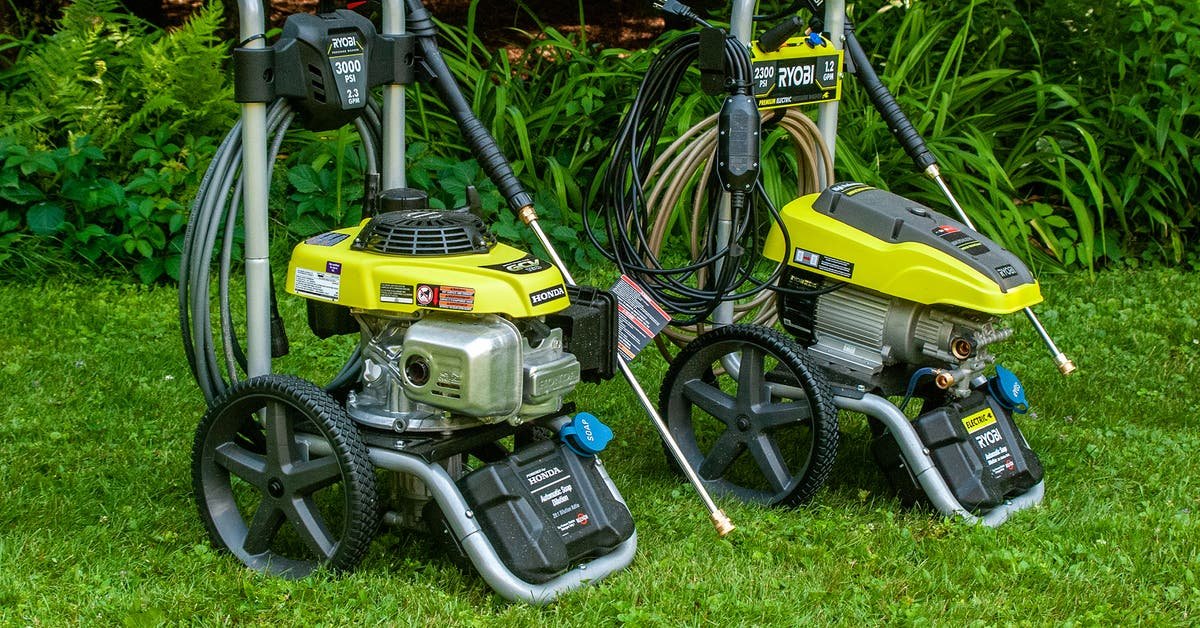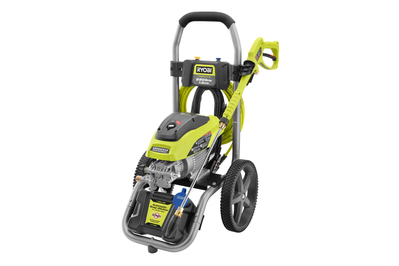
Top pick

With extra-large wheels, a long hose, a high-end induction motor, and a well-designed GFCI plug, this Ryobi model is the most user-friendly electric pressure washer.
After all of our testing and research, we’re confident that the best pressure washer is the Ryobi RY142500 2500 PSI Electric Pressure Washer. It didn’t clean much faster or better than the other models during our testing, but its smart design touches avoid nearly all of the inconveniences commonly associated with pressure washers. This model replaces our previous pick, the Ryobi RY142300, which has been discontinued.
It cleans well (but they all do). The Ryobi RY142500’s pressure rating of 2,500 psi is high for an electric pressure washer, but it has a relatively low flow rate of 1.2 gpm, so its actual cleaning ability is on a par with that of the other models we tried. We’ve never found the power lacking: In our tests, this model managed to get blobs of pine sap off a car and push away a graying layer of mildew on patio furniture. And in our years of long-term testing, Ryobi’s electric pressure washer has always delivered enough power for the job at hand.
Its induction motor adds a number of advantages. Induction motors are quieter and last longer than the smaller universal motors found on the majority of residential pressure washers. They’re also larger and heavier. In the case of the well-balanced RY142500, the added weight acts as a stabilizer. Even when we gave the hose a good tug, we were unable to tip over the unit.

The hose, cord, and wand storage are better than most. To store the Ryobi RY142500, you loop both the hose and cord and attach them to the washer with either a Velcro strap (the hose) or a bungee (the cord). Because they’re not stored in a tight loop, as on so many other pressure washers, when unwound they lie relatively flat. The hose and cord are also of higher quality than those on most competing models. And the wand holder actually does the job of holding the wand, something that most wand holders seem to be incapable of doing.

Its big wheels can traverse any lawn. At nearly a foot in diameter, the Ryobi RY142500’s wheels are almost twice as large as the wheels on most electric pressure washers. This made the RY142500 one of the easiest washers to maneuver, especially when we traveled over an uneven lawn, hopped a curb, and bumped it up a set of patio steps. Most of the wheels on the other washers were so bad, we had to half drag and half carry them.
The plug can fit any outlet. Due to a pressure washer’s combination of water and electricity, all models come with a ground fault circuit interrupter (GFCI) built into the power cord for added safety. The GFCI brick is always bulky, but Ryobi sets it several inches back from the plug end, which allows the plug to be normal size. Most other pressure washers have the GFCI built directly into the plug end, making them incompatible with covered exterior outlets.

Ryobi covers it with a three-year limited warranty. This is one of the longest warranties we found for an electric pressure washer. Ryobi tools are readily available at Home Depot too, and you can have any servicing done through that retailer as well, an option that adds to the overall convenience of this pressure washer.
Flaws but not dealbreakers
The soap dispenser is a problem. The Ryobi RY142500’s soap container is opaque, so you have no way to see how much detergent is left other than popping the cap off and taking a look. The cap is angled, so filling the container with detergent is difficult. But what’s worse is that the tank is bolted to the washer body, so to empty the tank, we had to tip the unit back and pull out the soap-supply hose on the underside of it. In doing this, it’s not easy to preserve the detergent for future use—in fact, we ended up just rolling the whole machine over on its side and dumping the detergent out on the lawn. Many other models have semi-opaque, removable tanks, with easy-to-access caps.

The nozzle selection and storage are a bit lacking. The Ryobi RY142500 comes with three nozzles (15-degree, soap, and a rotary turbo nozzle) but offers a place to store only two of them; this design decision assumes that one nozzle will always be on the tip of the wand. We would have liked to see a 40-degree nozzle, or at least a place to put one in case the owner purchases it separately. The previous version of this pressure washer had an extra storage spot, so it’s a bit of an unforced error for Ryobi not to include that on this newer model.





